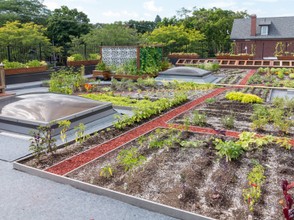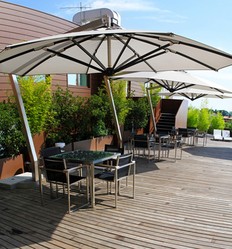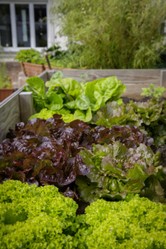A simple garden might make use of roll outs, which are mats seeded with wild flowers about which there was an article on Wizzley by Blackspanielgallery, the title being A Garden Made Simple. These have the advantage of being ready made and quite light, as they do not contain much soil, and as wild flowers do not use many nutrients [in fact they do not like nutrient-rich soil] they do not require much feeding. One advantage is that these roll outs do not require containers and therefore impose less strain on the roof than containers do.
Kitchen gardens on roofs are possible, though deep rooted vegetables such as potatoes and parsnips are possibly difficult in any bulk. In fact, you don't want bulk plantings, like potatoes, but lighter, specialist ones, for example a herb garden. Herbs like quite light, well drained soils and are not on the whole heavy. I have heard that somewhere in London there is a chef who grows his herbs in a roof garden.
A herb garden on the roof is ideal, There are four main families of herbs. First is the Umbellifers. These include parsley, sweet cicely , coriander, chervil and fennel. This family includes basil, sage and thyme. Then there is the Mint family, with all the rich varieties of mint. We find the liliaceae, the lily family, whose edible members include garlic, chives leeks and onions. The Brassica family include mustard and horse radish. The fifth main herb family is ginger, but that is a tropical tree and so not suitable for roofs or a colder climate.
Yet a roof garden can also provide a rich range of salad vegetables,planted in succession. And one great advantage is that the roof is freer of perennial weeds than the soil is. you will not find bindweed in your pots. The roof is therefore a controlled environment. You might even have a greenhouse, ideally a fabric one to save weight, and some roofs. This would give you tomatoes, cucumbers and melons.
But for many people their roof is a sanctuary, a place to sit above the hustle of the city. They enjoy a rich network of flowers. These will not be densely packed, for they will be laid in light containers separated by paths. Roses are very popular, but there can be a whole range of flowers according to taste. In this sense a roof garden has an advantage over a balcony, as balconies can be shaded. Only recently I was visited by a young lady from Buenos Aires [seeing my youngest son] who told me that she would love to grow something on her balcony, but it was too shaded. My solution: I went to my book shelf and gave her Plants for Shade. I needed it when taking my gardening certificates, but never since then, as shade is not an issue for me. I am promised that she will send me a picture of her balcony.
But roofs can be a safe space for bees. The city tends to be free of the worst pesticides that are decimating bee colonies. It is also replete with flowery gardens. Bee heaven! Yet another advantage is that bees dislike dogs and horses, neither of which are common on roofs. Dogs maybe on occasion, but when did you ever see a horse on a roof? Cats, maybe, but bees do not dislike them as they dislike dogs








 Women of the Gospelson 10/11/2025
Women of the Gospelson 10/11/2025
 Religious Gardenson 08/25/2025
Religious Gardenson 08/25/2025
 Doctor of the Church: John Henry Newmanon 08/03/2025
Doctor of the Church: John Henry Newmanon 08/03/2025
 Restoring the Palm Houseon 07/16/2025
Restoring the Palm Houseon 07/16/2025



Comments
I can use stairs, though I hold firmly to the banister. Maureen is insistent that I abide by the advice on ladders. When I was diagnosed with Parkinsonism Professor Roberts said firmly that I must never fall. Maureen abides by this advice strictly.
Your outdoor image in one of your earlier wizzleys leads me to believe that you have at least a two-story house.
Some houses here have outdoor stairways, like indoor stairways between floors, built into the walls between first-, ground-level and the next.
Might medical orders exclude you from this alternative to house-exterior ladders?
A structural engineer must check the building. Sadly, I am not allowed to climb ladders, medical orders, so a roof garden is impossible for me.
Roof gardens are so attractive!
Is there a certification or an inspection process by some agency before one can put one in?
Medium sized palms! That is a new one to me. You could do this in a building designed to be strong enough to hold a roof garden. You are right that gardens are good anywhere.
I have recently been elected chairman of Trafford Allotment Federation, which places me at the apex of my borough's gardening establishment, a position that I can hold for three years. I am trying to use what political influence that the position gives me to encourage widening garden provision in this crowded area and more participation. My position is one of influence rather than power.
I am enchanted by roof gardens. At back of my house there is a roof garden I admire. In fact, this garden hosts medium sized palm trees, flowering plants and others. Gardens are good anywhere and everywhere. They give you a whiff of fresh air amidst the jungle of concrete and structures. Though a roof garden cannot imbibe the many features of an otherwise ground garden such as water features, cascades and bulky features, it still can provide breathing space and a serene green retreat.
The four families give us a wide range of culinary herbs to relish, that's to my mind the advantage of them.
I like gardens, but if I were asked to choose I would say Kensington Roof Garden,which covers a large area on top of the old Derry and Toms building.
frankbeswick, It must have been quite a sight to view the hanging gardens of Atlantis, Babylon, and Tenochtitlán.
There's some controversy over the use of the word aquarium regarding Rosewell, when the great house was being visited by Thomas Jefferson. It may refer to the way in which the flat, parapeted roof was built or to the placement of fish bowls and gardens near the telescope viewing area.
So flat roofs always call up visions of the possibility of rooftop gardens, like in the film "Kate and Leopold."
What is the advantage of each of the four herb garden types (I'm discounting the fifth, ginger) in terms of rooftop gardening or does it really just come down to preference?
Do you have any favorite famous rooftop gardens?
Enjoyed your article. I live in Colorado where there are a few roof gardens downtown.
Of course! Why did I did not think of it? Your idea about empty business roof tops is a great one, and it could help green the cities and make a real contribution to fighting climate change.